2010 TOYOTA COROLLA remote control
[x] Cancel search: remote controlPage 2 of 476
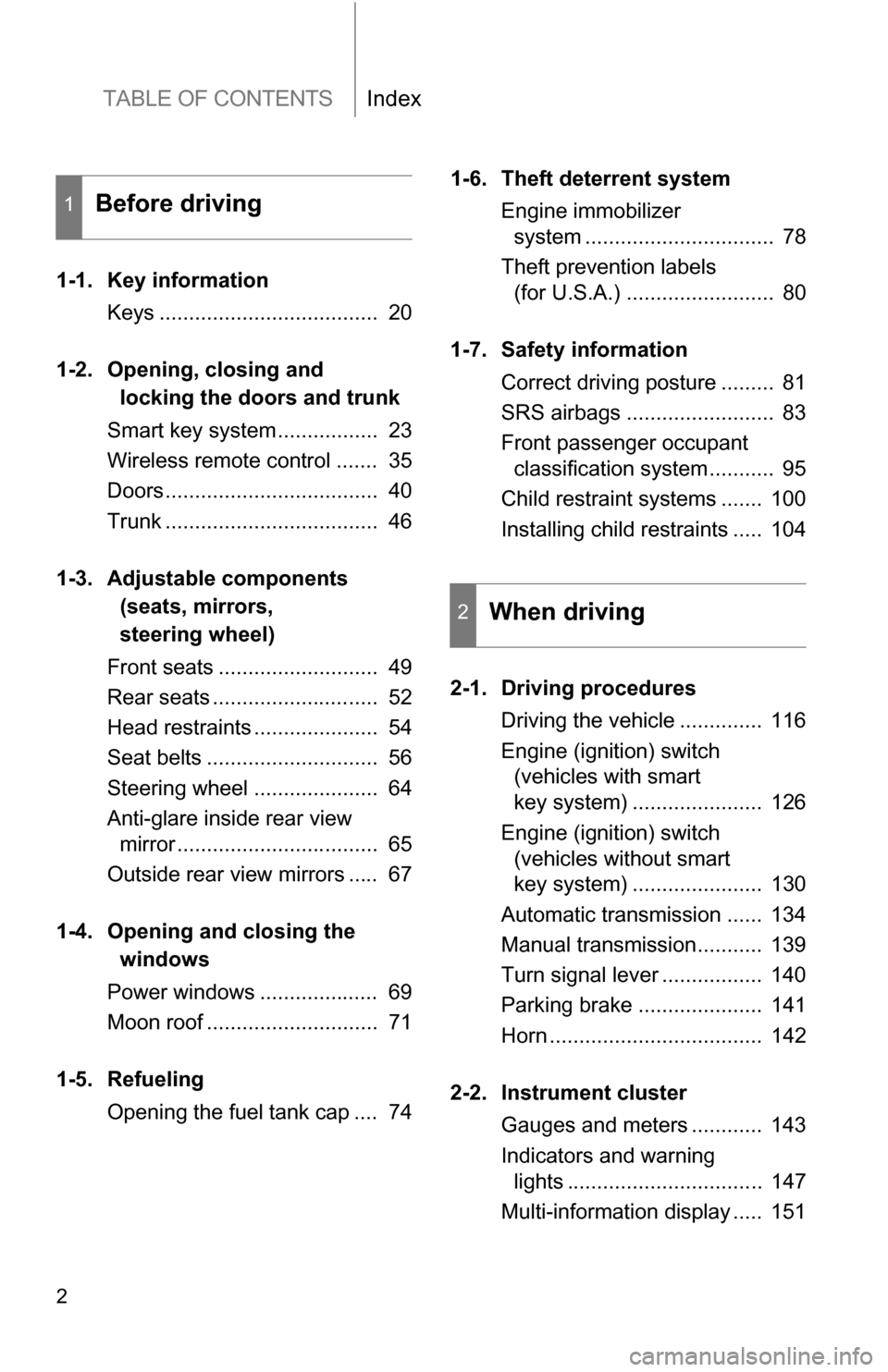
TABLE OF CONTENTSIndex
2
1-1. Key informationKeys ..................................... 20
1-2. Opening, closing and locking the doors and trunk
Smart key system................. 23
Wireless remote control ....... 35
Doors.................................... 40
Trunk .................................... 46
1-3. Adjustable components (seats, mirrors,
steering wheel)
Front seats ........................... 49
Rear seats ............................ 52
Head restraints ..................... 54
Seat belts ............................. 56
Steering wheel ..................... 64
Anti-glare inside rear view mirror .................................. 65
Outside rear view mirrors ..... 67
1-4. Opening and closing the windows
Power windows .................... 69
Moon roof ............................. 71
1-5. Refueling Opening the fuel tank cap .... 74 1-6. Theft deterrent system
Engine immobilizer system ................................ 78
Theft prevention labels (for U.S.A.) ......................... 80
1-7. Safety information Correct driving posture ......... 81
SRS airbags ......................... 83
Front passenger occupant classification system ........... 95
Child restraint systems ....... 100
Installing child restraints ..... 104
2-1. Driving procedures Driving the vehicle .............. 116
Engine (ignition) switch (vehicles with smart
key system) ...................... 126
Engine (ignition) switch (vehicles without smart
key system) ...................... 130
Automatic transmission ...... 134
Manual transmission........... 139
Turn signal lever ................. 140
Parking brake ..................... 141
Horn .................................... 142
2-2. Instrument cluster Gauges and meters ............ 143
Indicators and warning lights ................................. 147
Multi-information display ..... 151
1Before driving
2When driving
Page 13 of 476
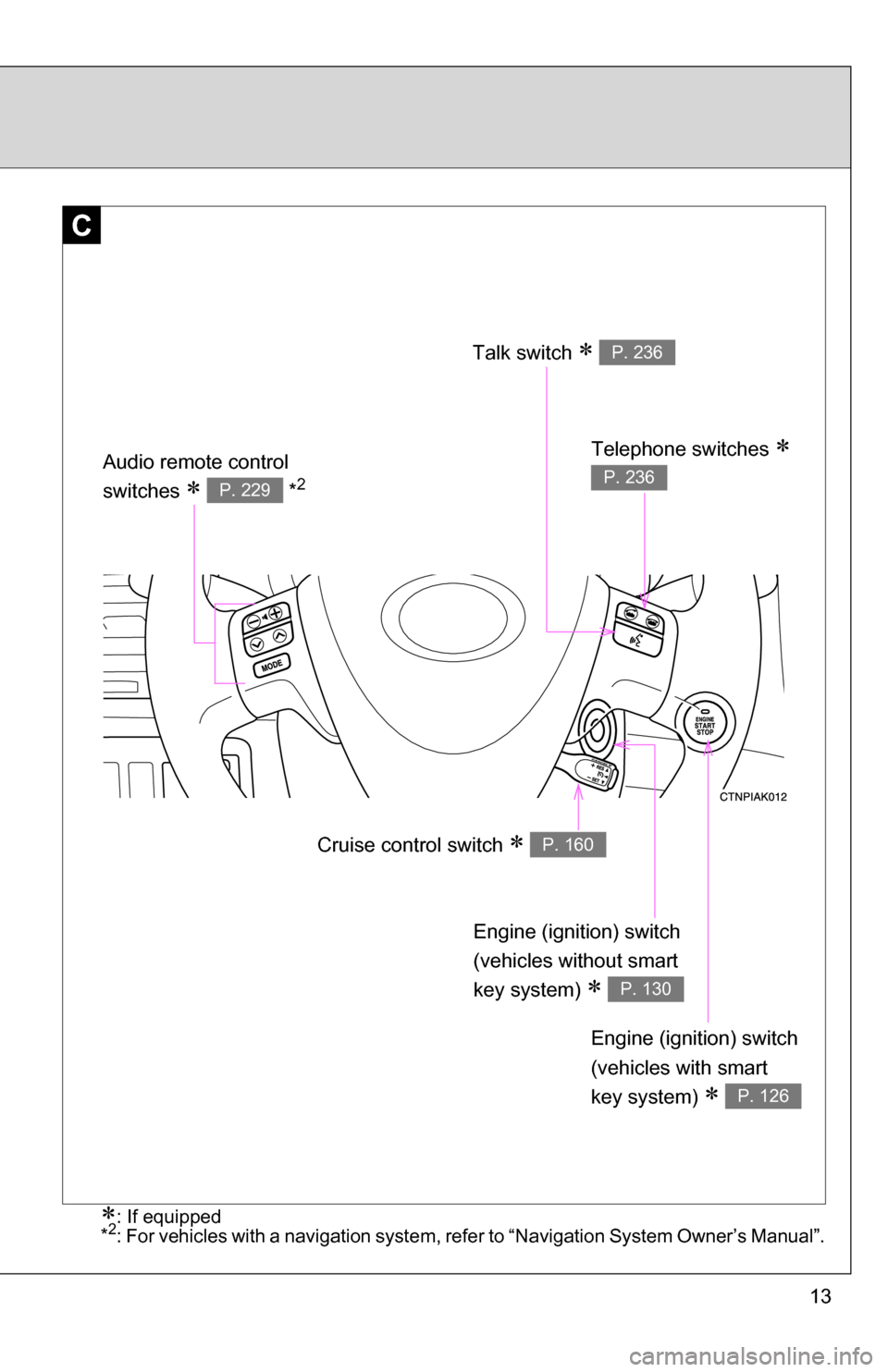
13
C
Cruise control switch P. 160
Talk switch P. 236
Engine (ignition) switch
(vehicles without smart
key system)
P. 130
Engine (ignition) switch
(vehicles with smart
key system)
P. 126
Audio remote control
switches
*2P. 229
Telephone switches
P. 236
: If equipped
*2: For vehicles with a navigation system, refer to “Navigation System Owner’s Manual”.
Page 19 of 476
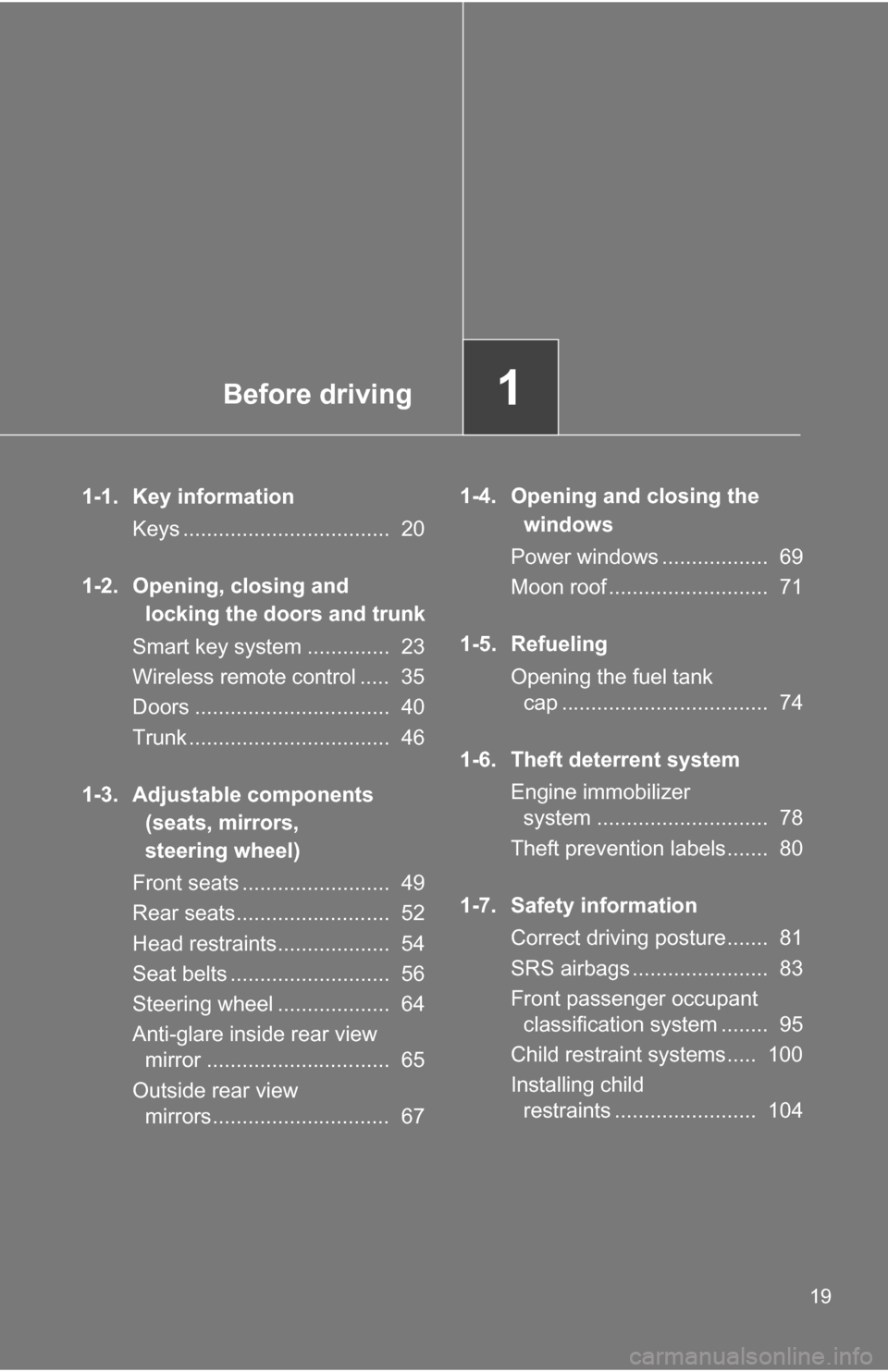
Before driving1
19
1-1. Key informationKeys ................................... 20
1-2. Opening, closing and locking the doors and trunk
Smart key system .............. 23
Wireless remote control ..... 35
Doors ................................. 40
Trunk .................................. 46
1-3. Adjustable components (seats, mirrors,
steering wheel)
Front seats ......................... 49
Rear seats.......................... 52
Head restraints................... 54
Seat belts ........................... 56
Steering wheel ................... 64
Anti-glare inside rear view mirror ............................... 65
Outside rear view mirrors.............................. 67 1-4. Opening and closing the
windows
Power windows .................. 69
Moon roof ........................... 71
1-5. Refueling Opening the fuel tank cap ................................... 74
1-6. Theft deterrent system Engine immobilizer system ............................. 78
Theft prevention labels....... 80
1-7. Safety information Correct driving posture....... 81
SRS airbags ....................... 83
Front passenger occupant classification system ........ 95
Child restraint systems..... 100
Installing child restraints ........................ 104
Page 20 of 476
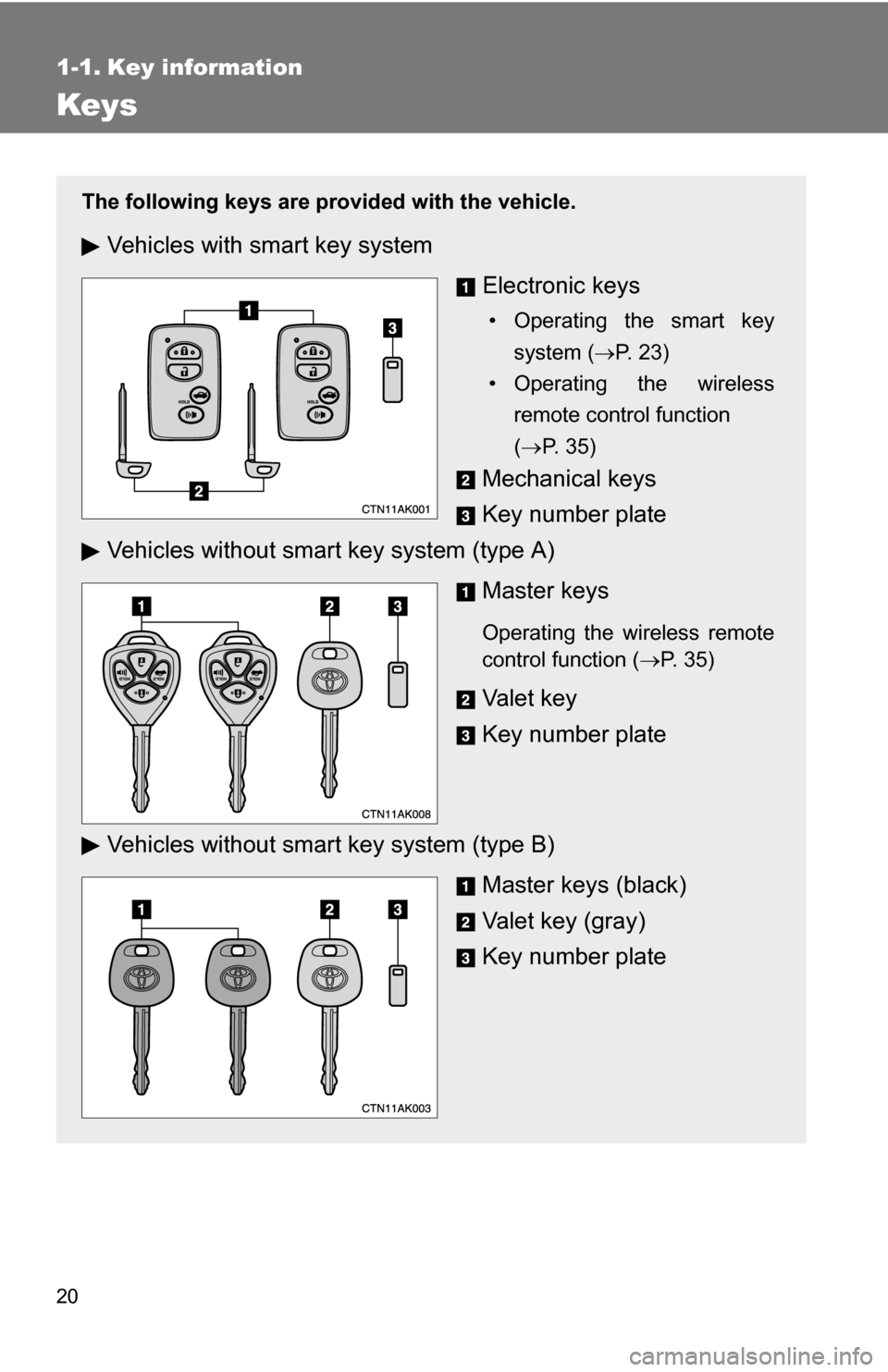
20
1-1. Key information
Keys
The following keys are provided with the vehicle.
Vehicles with smart key system
Electronic keys
• Operating the smart keysystem ( P. 23)
• Operating the wireless remote control function
( P. 35)
Mechanical keys
Key number plate
Vehicles without smar t key system (type A)
Master keys
Operating the wireless remote
control function ( P. 35)
Va l e t k e y
Key number plate
Vehicles without smar t key system (type B)
Master keys (black)
Valet key (gray)
Key number plate
Page 21 of 476
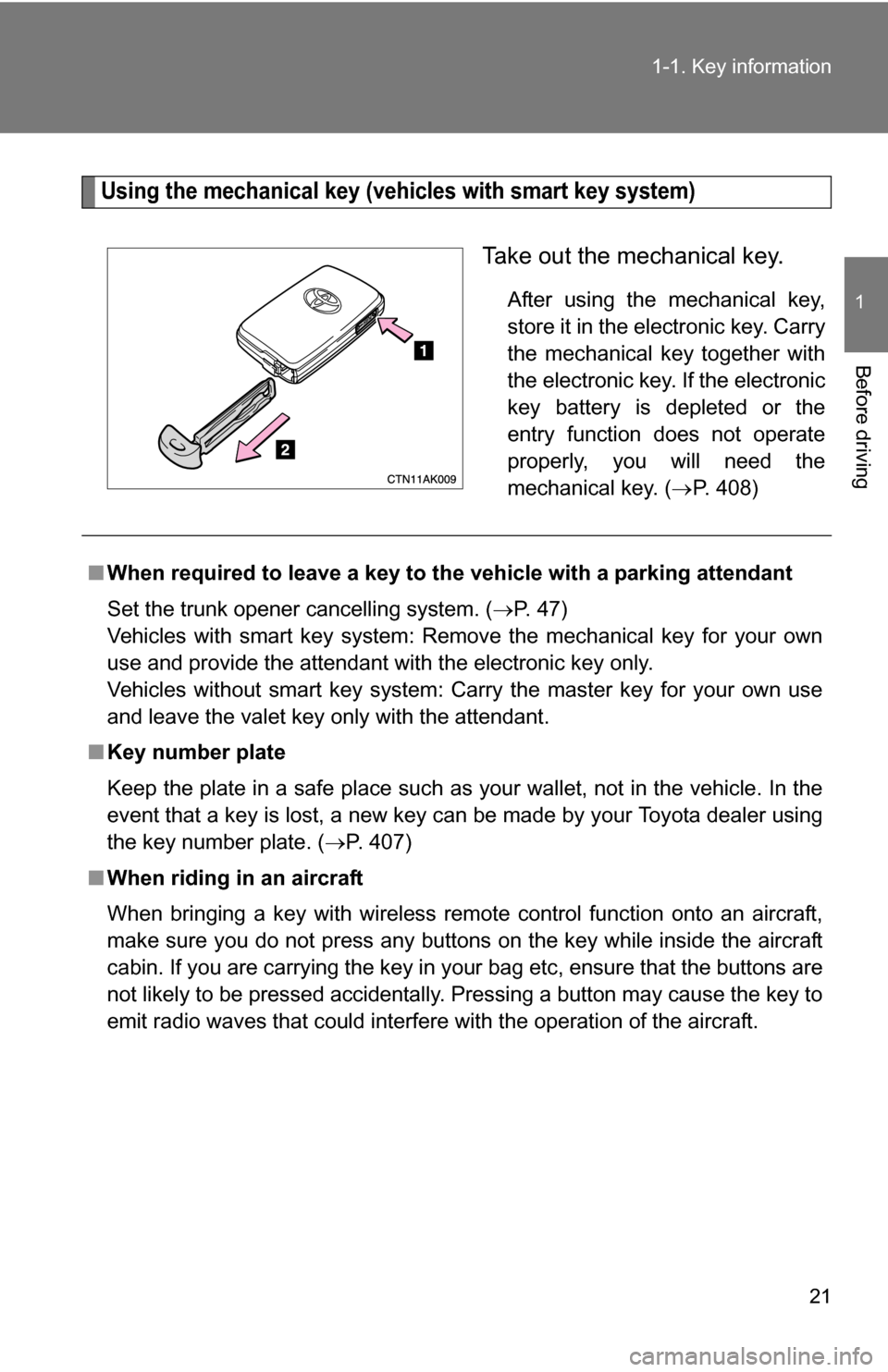
21
1-1. Key information
1
Before driving
Using the mechanical key (vehicles with smart key system)
Take out the mechanical key.
After using the mechanical key,
store it in the electronic key. Carry
the mechanical key together with
the electronic key. If the electronic
key battery is depleted or the
entry function does not operate
properly, you will need the
mechanical key. (
P. 408)
■When required to leave a key to th e vehicle with a parking attendant
Set the trunk opener cancelling system. ( P. 47)
Vehicles with smart key system: Remove the mechanical key for your own
use and provide the attendant with the electronic key only.
Vehicles without smart key system: Carry the master key for your own use
and leave the valet key only with the attendant.
■ Key number plate
Keep the plate in a safe place such as your wallet, not in the vehicle. In the
event that a key is lost, a new key can be made by your Toyota dealer using
the key number plate. ( P. 407)
■ When riding in an aircraft
When bringing a key with wireless remote control function onto an aircra\
ft,
make sure you do not press any buttons on the key while inside the aircraft
cabin. If you are carrying the key in your bag etc, ensure that the buttons are
not likely to be pressed accidentally. Pressing a button may cause the key to
emit radio waves that could interfere with the operation of the aircraft.
Page 27 of 476
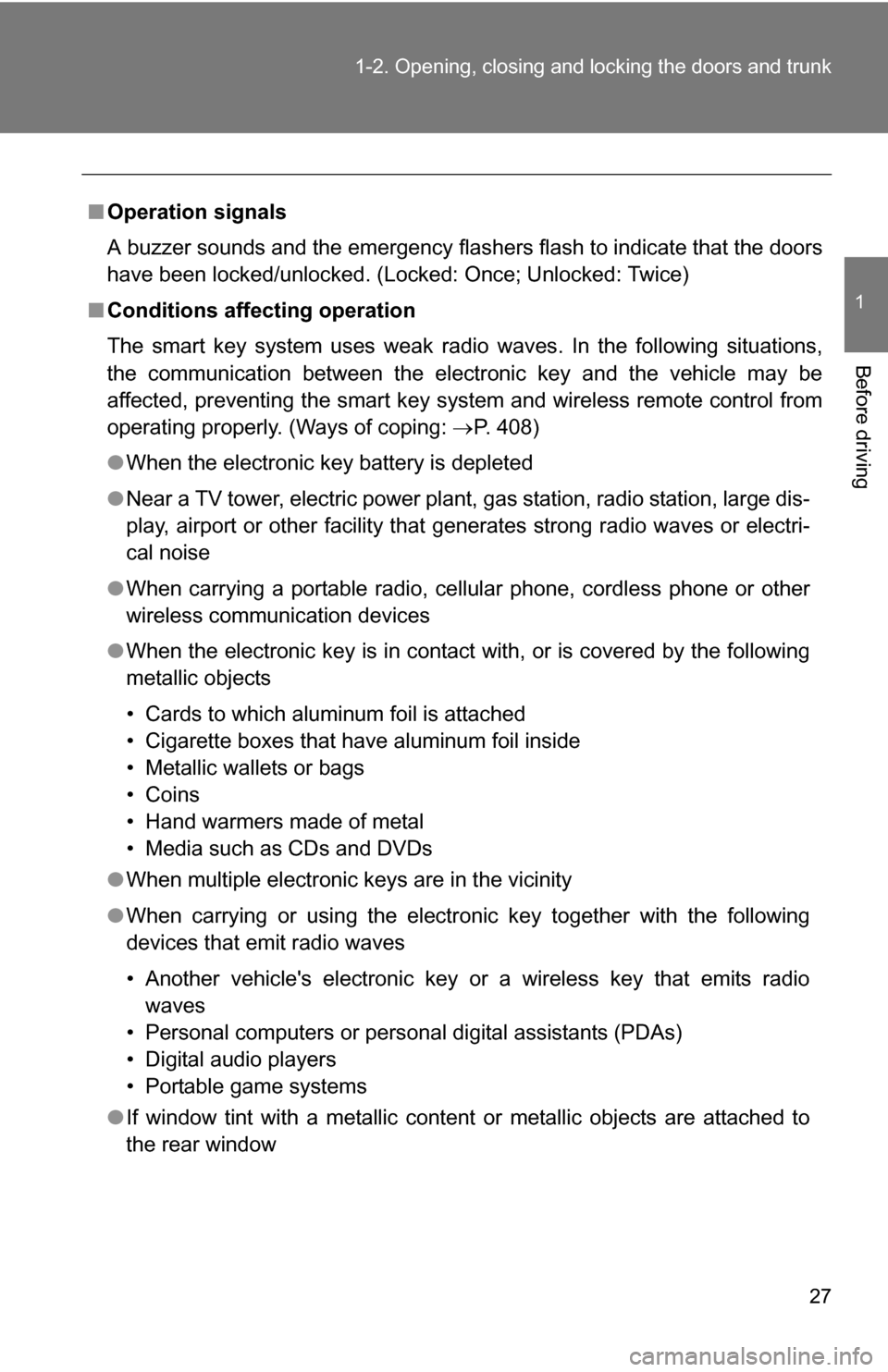
27
1-2. Opening, closing and locking the doors and trunk
1
Before driving
■
Operation signals
A buzzer sounds and the emergency flashers flash to indicate that the doors
have been locked/unlocked. (Locked: Once; Unlocked: Twice)
■ Conditions affecting operation
The smart key system uses weak radio waves. In the following situations,
the communication between the electronic key and the vehicle may be
affected, preventing the smart key system and wireless remote control from
operating properly. (Ways of coping: P. 408)
● When the electronic key battery is depleted
● Near a TV tower, electric power plant, gas station, radio station, large dis-
play, airport or other facility that generates strong radio waves or electri-
cal noise
● When carrying a portable radio, ce llular phone, cordless phone or other
wireless communication devices
● When the electronic key is in contact with, or is covered by the following
metallic objects
• Cards to which aluminum foil is attached
• Cigarette boxes that have aluminum foil inside
• Metallic wallets or bags
• Coins
• Hand warmers made of metal
• Media such as CDs and DVDs
● When multiple electronic keys are in the vicinity
● When carrying or using the electronic key together with the following
devices that emit radio waves
• Another vehicle's electronic key or a wireless key that emits radio
waves
• Personal computers or personal digital assistants (PDAs)
• Digital audio players
• Portable game systems
● If window tint with a metallic content or metallic objects are attached to
the rear window
Page 28 of 476
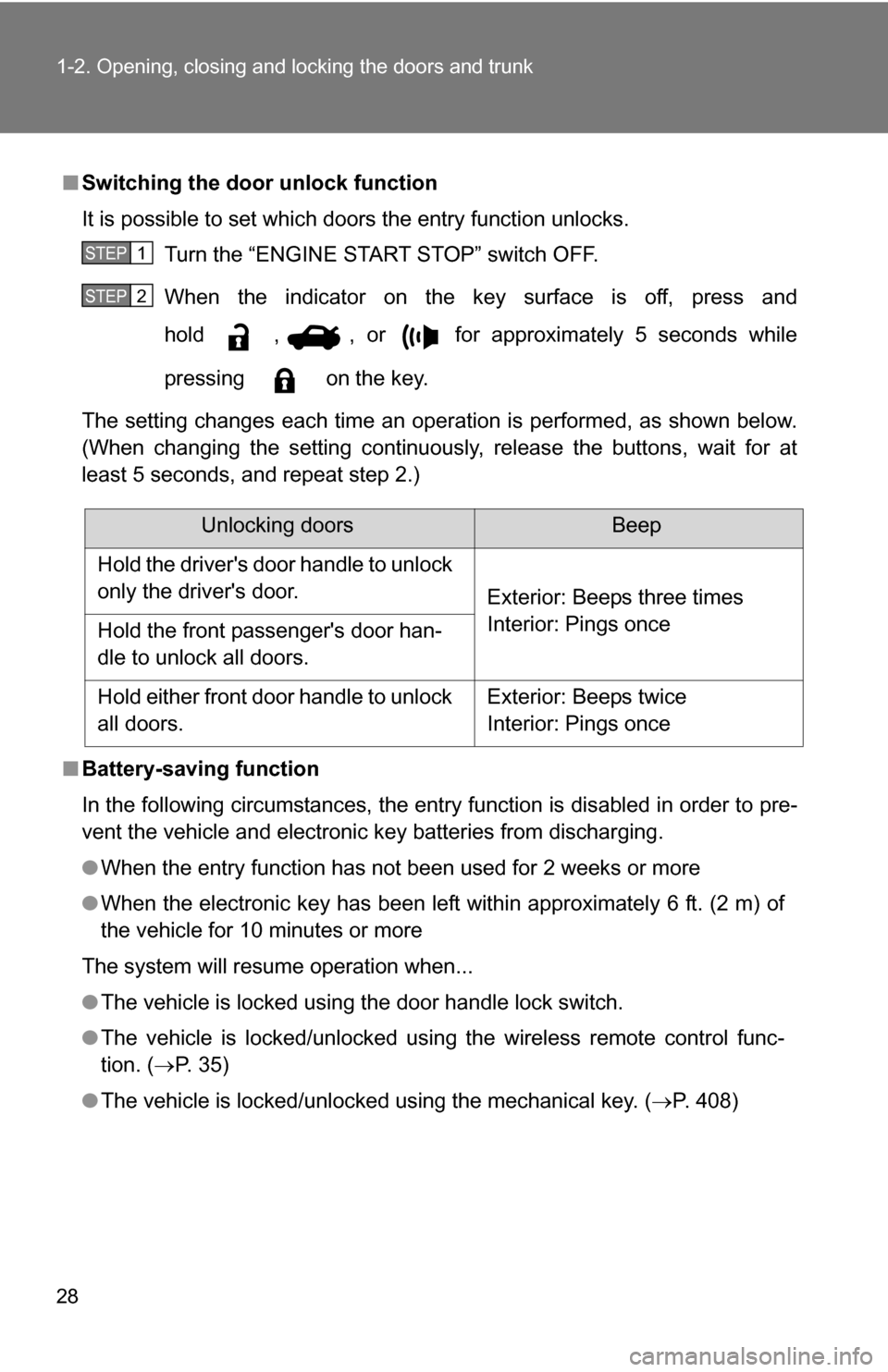
28 1-2. Opening, closing and locking the doors and trunk
■Switching the door unlock function
It is possible to set which doors the entry function unlocks.
Turn the “ENGINE START STOP” switch OFF.
When the indicator on the key surface is off, press and
hold , , or for approximately 5 seconds while
pressing on the key.
The setting changes each time an operation is performed, as shown below.
(When changing the setting continuously, release the buttons, wait for at
least 5 seconds, and repeat step 2.)
■ Battery-saving function
In the following circumstances, the entry function is disabled in order to pre-
vent the vehicle and electronic key batteries from discharging.
●When the entry function has not been used for 2 weeks or more
● When the electronic key has been left within approximately 6 ft. (2 m) of
the vehicle for 10 minutes or more
The system will resume operation when...
● The vehicle is locked using the door handle lock switch.
● The vehicle is locked/unlocked using the wireless remote control func-
tion. ( P. 3 5 )
● The vehicle is locked/unlocked using the mechanical key. ( P. 408)
STEP 1
STEP 2
Unlocking doorsBeep
Hold the driver's door handle to unlock
only the driver's door. Exterior: Beeps three times
Interior: Pings once
Hold the front passenger's door han-
dle to unlock all doors.
Hold either front door handle to unlock
all doors. Exterior: Beeps twice
Interior: Pings once
Page 29 of 476
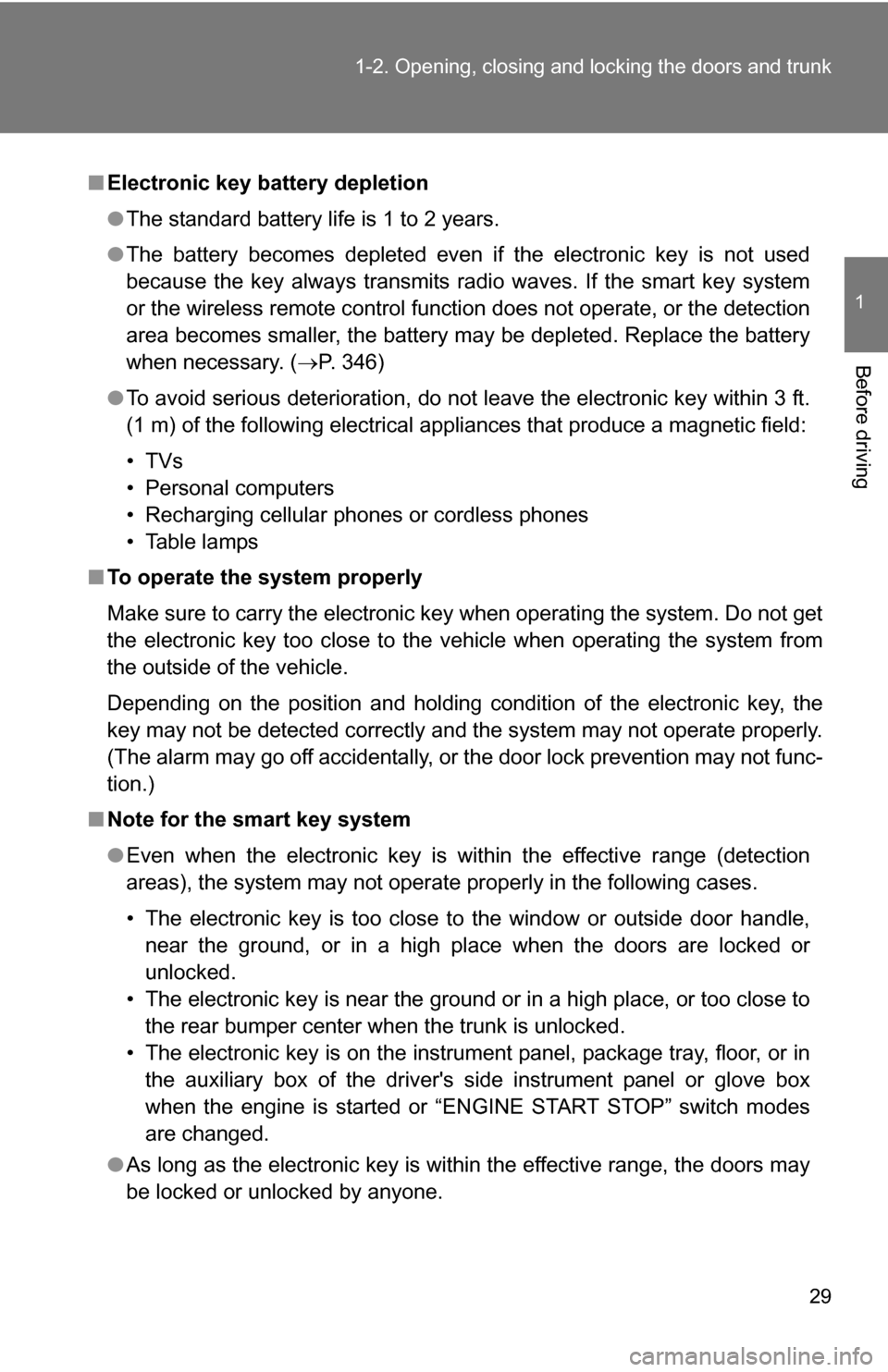
29
1-2. Opening, closing and locking the doors and trunk
1
Before driving
■
Electronic key battery depletion
●The standard battery life is 1 to 2 years.
● The battery becomes depleted even if the electronic key is not used
because the key always transmits radio waves. If the smart key system
or the wireless remote control function does not operate, or the detection
area becomes smaller, the battery may be depleted. Replace the battery
when necessary. ( P. 346)
● To avoid serious deterioration, do not leave the electronic key within 3 ft.
(1 m) of the following electrical appliances that produce a magnetic field:
•TVs
• Personal computers
• Recharging cellular phones or cordless phones
• Table lamps
■ To operate the system properly
Make sure to carry the electronic key when operating the system. Do not get
the electronic key too close to the vehicle when operating the system from
the outside of the vehicle.
Depending on the position and holding condition of the electronic key, the
key may not be detected correctly and the system may not operate properly.
(The alarm may go off accidentally, or the door lock prevention may not func-
tion.)
■ Note for the smart key system
●Even when the electronic key is within the effective range (detection
areas), the system may not operate properly in the following cases.
• The electronic key is too close to the window or outside door handle,
near the ground, or in a high place when the doors are locked or
unlocked.
• The electronic key is near the ground or in a high place, or too close to the rear bumper center when the trunk is unlocked.
• The electronic key is on the instrument panel, package tray, floor, or in the auxiliary box of the driver's side instrument panel or glove box
when the engine is started or “ENGINE START STOP” switch modes
are changed.
● As long as the electronic key is within the effective range, the doors may
be locked or unlocked by anyone.